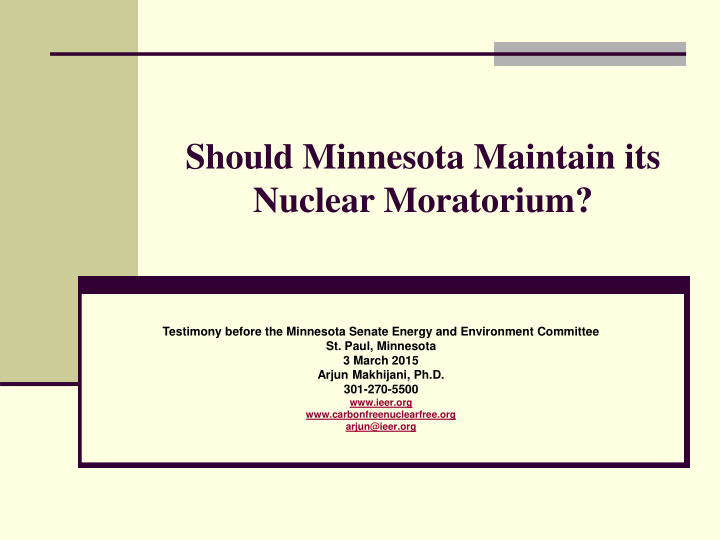



Should Minnesota Maintain its Nuclear Moratorium? Testimony before the Minnesota Senate Energy and Environment Committee St. Paul, Minnesota 3 March 2015 Arjun Makhijani, Ph.D. 301-270-5500 www.ieer.org www.carbonfreenuclearfree.org arjun@ieer.org
Everything on the table: good for smorgasbord; but not for a smart grid 2
Electricity costs, no subsidies, except Price-Anderson for nuclear; nuclear costs can go up to $200/MWh Chart Title Nuclear Efficiency Wind, onshore Solar - utility scale 2017 solar - utility scale Solar rooftop, C&I, 2020 Solar rooftop, C&I, current $0 $20 $40 $60 $80 $100 $120 $140 $160 $180 3 delivered cost, $/MWh generation, $/MWh
Some critical issues, Slide 1 – Long lead times and delays Nuclear has very long lead times and huge total initial investment. Progress Energy (now owned by Duke) in Florida proposed a two- reactor project north of $20 billion, but the market capitalization of the whole company was about half that. Solar can be built in months; wind in ~2 years. Long-term forecasts have generally been wrong since 1973. About 120 nuclear reactors cancelled since 1973 – almost as many as were built – wasting $30 billion (2012 dollars). Vogtle 3, lead new reactor, is 21 months delayed. No official opening date as of November 2014. V.C. Summer, in South Carolina, 2 ½ year delay. NRG proposed two reactors in South Texas – now moribund after hundreds of millions spent on paperwork. Most “nuclear renaissance” reactor projects halted or moribund. 4
Risk Ratepayers pay in advance for reactor construction and take the risk (“Construction work in progress” CWIP). No refunds if the plant is not finished. No ownership of the plant for ratepayers if it is. This is worse than a tax. Floridians have paid hundreds of millions of dollars for nuclear projects that are stopped. But the payments go on! 5
Let them have pools 6
And casks NRC now says can store on site for thousands of years Federal government will appropriate money every year for security and infrastructure, long after plants are shut It said this in the midst of a government shut down NRC File Photo: number 20100907-014 7
Fukushima Daiichi - March 18, 2011: An similar accident at a Minnesota plant would devastate the Mississippi River basin, especially due to strontium-90 Satellite imagery courtesy of GeoEye/EyeQ
Put nuclear on the table? Putting nuclear on the table will not advance energy policy in Minnesota. Rather, it will suck all the oxygen out of the energy policy discussion. Next step for the nuclear lobby may well be to ask for ratepayer advance payments (Construction work in progress). Note: No CWIP, no utility interest in nuclear. That is the case now in Minnesota. Why ask for trouble? Nuclear industry is undermining renewables, as for instance in Illinois 9
Nuclear is inflexible: a poor complement to solar and wind Building more centralized plants, especially the most inflexible one, nuclear, is exactly the wrong direction. We need flexible responsive complements to solar and wind: hydro, natural gas, demand response, storage… Nuclear plants are too inflexible to support high penetration of solar and wind, MN’s best resources, and the Midwest’s greatest resources. The Midwest has more wind energy potential than all OPEC countries have oil. We need to build distributed resilient grid with responsive elements at all scales from small to large. We don’t need new nuclear power; rather it is a hindrance and needless risk to achieving an emissions-free future. 10
Modeling 100% Renewable MN (IEER): Many studies now show renewable, emissions-free electricity system is feasible and desirable Mon Tues Wed Fri Sat Sun Thurs
Conclusions Minnesota is now a leader in the United States on an excellent course to reduce emissions, become more efficient, and have a resilient, democratized and renewable grid. Ending the nuclear moratorium will divert attention from the task at hand, at best At worst, it will derail Minnesota from its present course, if there are irresistible pressures for Construction Work in Progress. Nuclear is not needed for an emissions free electricity sector. It is a risky and costly option that should e avoided. This will hurt jobs, emission reductions, resiliency, renewables, and a once-in-a century opportunity to democratize the grid. 12
Recommend
More recommend